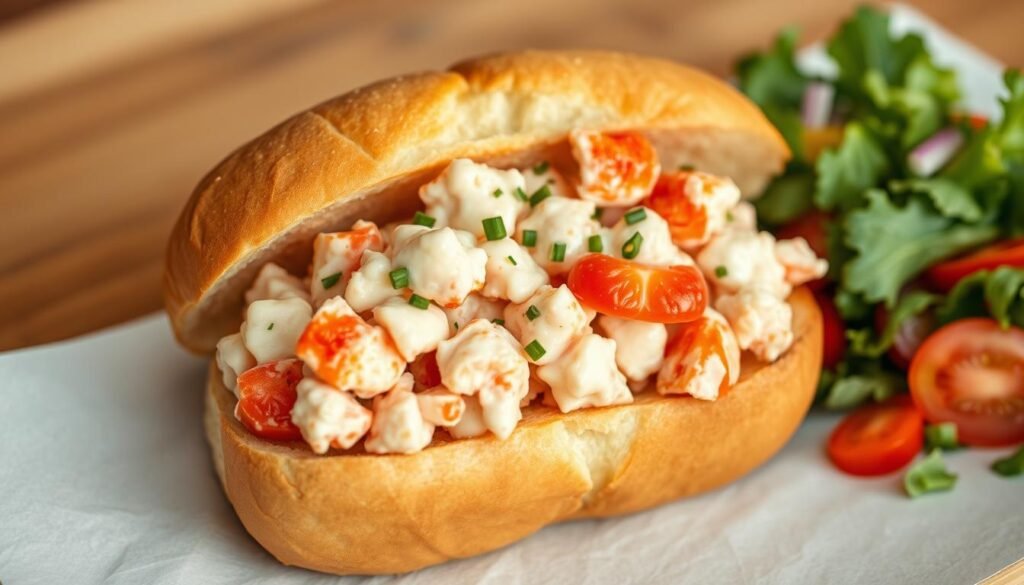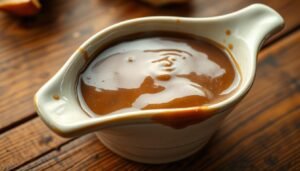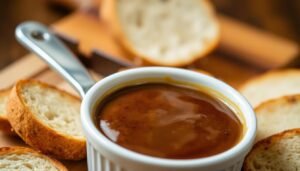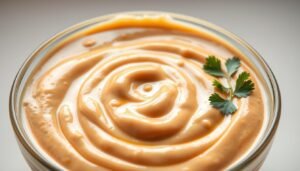Did you know Maine eats over 10 million pounds of lobster meat every year? This shows how much people love lobster rolls. I’m excited to share an easy lobster roll recipe that you can make at home.
Making lobster rolls is easier than you might think. You just need cooked lobster meat, mayonnaise, and celery. These simple ingredients make a dish that’s perfect for any time. For a step-by-step guide, check out this link.
Key Takeaways
- Easy to make with just a few ingredients
- Perfect for a quick and delicious meal
- Bring the taste of Maine to your kitchen
- Can be customized with your favorite flavors
- Great for special occasions or everyday dining
What is a Lobster Roll?
A lobster roll is more than just a meal; it’s an experience that brings the taste of the ocean to your plate. This beloved dish has a rich history and varies significantly across different regions.
A Brief History of Lobster Rolls
The origins of the lobster roll date back to the early 20th century in New England, where lobster was abundant and became a staple in local cuisine. Initially, lobster rolls were served at roadside stands and were simple, consisting of lobster meat served on a bun.
The evolution of the lobster roll was influenced by local traditions and the availability of ingredients. Over time, it gained popularity and spread beyond New England, with various regions adopting their own versions.
Regional Variations in the U.S.
As the lobster roll gained popularity across the U.S., different regions began to put their own twist on the dish. From the traditional Maine-style lobster roll, which is served cold with mayonnaise, to the Connecticut-style, which is served hot with butter, the variations are numerous.
| Region | Style | Key Ingredients |
|---|---|---|
| Maine | Cold | Lobster meat, mayonnaise, celery |
| Connecticut | Hot | Lobster meat, butter, lemon |
| New York | Varied | Lobster meat, mayonnaise, herbs |
Each region offers a unique take on the lobster roll, making it a versatile dish that can be enjoyed in many different ways.
Essential Ingredients for the Perfect Lobster Roll
To make a truly exceptional lobster roll, focus on the essentials. The quality of your ingredients will impact the flavor and overall experience.
Fresh Lobster Selection
The star of the show is, of course, the lobster. Look for firm, succulent meat when selecting fresh lobster. I prefer using chunks of lobster meat for my rolls, as they provide a generous and tender bite. If you’re purchasing whole lobsters, ensure they are lively and have a good weight to them, indicating freshness.
Condiments and Additions
While lobster is the main attraction, the right condiments and additions can elevate your roll. Mayonnaise is a classic addition, helping to bind the lobster meat together. You can also consider adding a squeeze of fresh lemon juice, a sprinkle of chopped herbs like parsley or chives, and a dash of salt and pepper to taste. For a unique twist, a drizzle of limoncello can add a delightful citrus note.
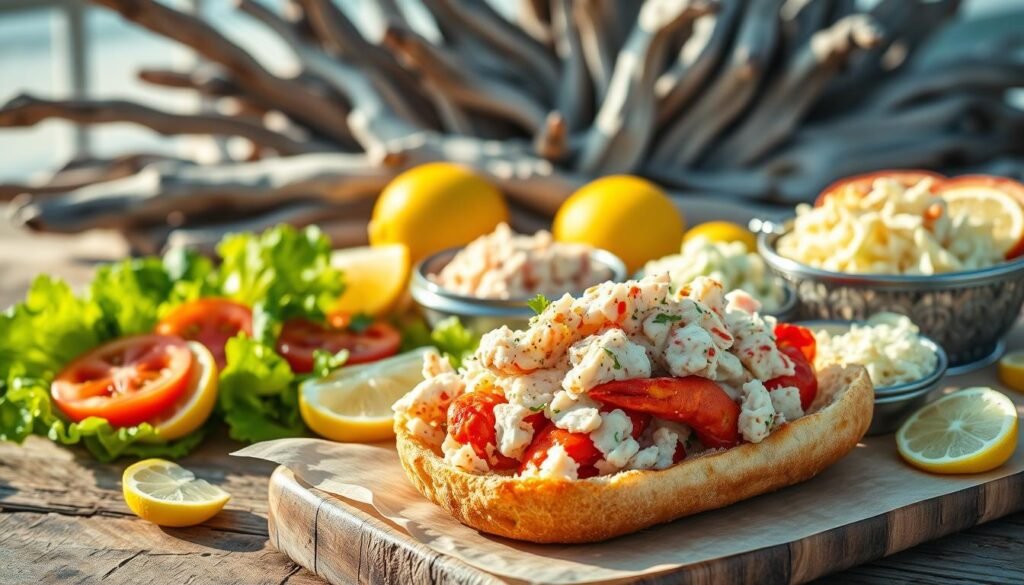
Choosing the Right Bread
The bread is more than just a vessel for your lobster filling; it’s an integral part of the overall experience. Traditional lobster rolls are served on a soft, split-top bun. Look for buns that are lightly toasted to provide a subtle crunch without overpowering the tender lobster meat. Some recipes suggest grilling or buttering the buns for added flavor.
| Ingredient | Description | Tips |
|---|---|---|
| Fresh Lobster | Chunks or whole lobsters | Look for firm, succulent meat |
| Mayonnaise | Classic binder | Use lightly to avoid overpowering the lobster |
| Lemon Juice | Adds brightness | Squeeze fresh for the best flavor |
| Split-top Buns | Traditional serving method | Lightly toast for added texture |
Tools You’ll Need for Preparation
Having the right kitchen tools is key for a delicious lobster roll. The right tools make preparation easier and more enjoyable.
Kitchen Essentials
You’ll need basic kitchen tools to begin. A large pot is essential for boiling or steaming the lobster. Choose a pot that’s at least 4-quart to fit the lobster.
A strainer or steamer basket is crucial for removing the lobster from the water. For cutting the lobster meat, a good quality knife and a cutting board are necessary. A meat pick or fork helps in getting the meat out of the shell.
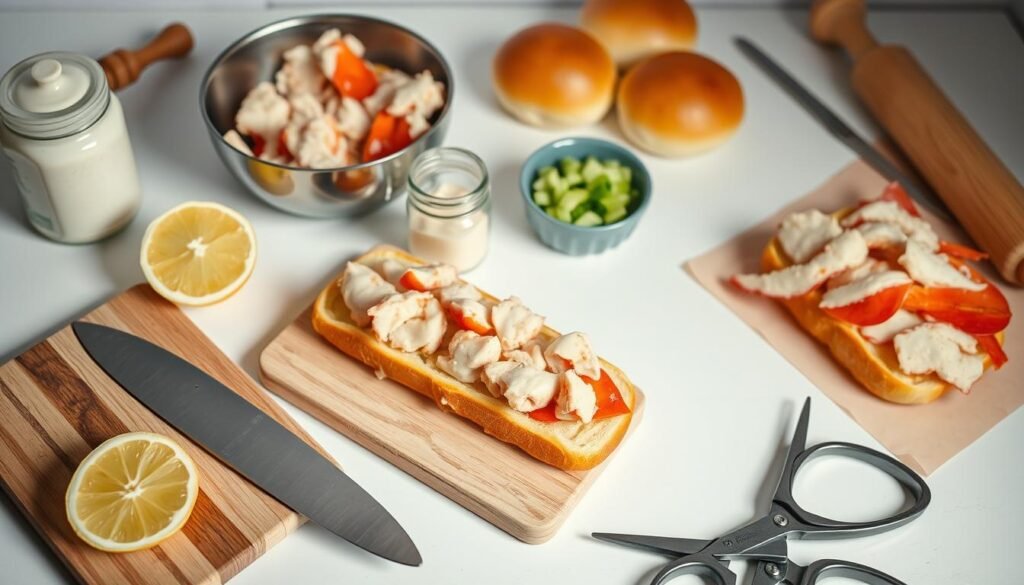
Optional Gadgets
Some gadgets can make preparation easier, though not necessary. A lobster cracker is handy for cracking claws and tail. For a citrus twist, consider a lemon juicer.
For a refreshing drink, try making a limoncello to go with your lobster roll. A mixing bowl and a gentle spoon are useful for mixing the lobster salad without breaking the meat.
Steps to Cook Lobster for Your Roll
To make the perfect lobster roll, you first need to master the art of cooking lobster. This involves choosing the right cooking method and executing it flawlessly.
Boiling vs. Steaming Lobster
There are two main ways to cook lobster: boiling and steaming. Boiling means putting the lobster in boiling water. Steaming involves placing it in a steamer basket over boiling water, covered with a lid. Boiling can make the lobster taste more flavorful because of direct water contact. But, it can also make the lobster lose some of its delicate flavor and texture if cooked too long.
Steaming is a gentler method that keeps the lobster’s natural flavor and texture better.
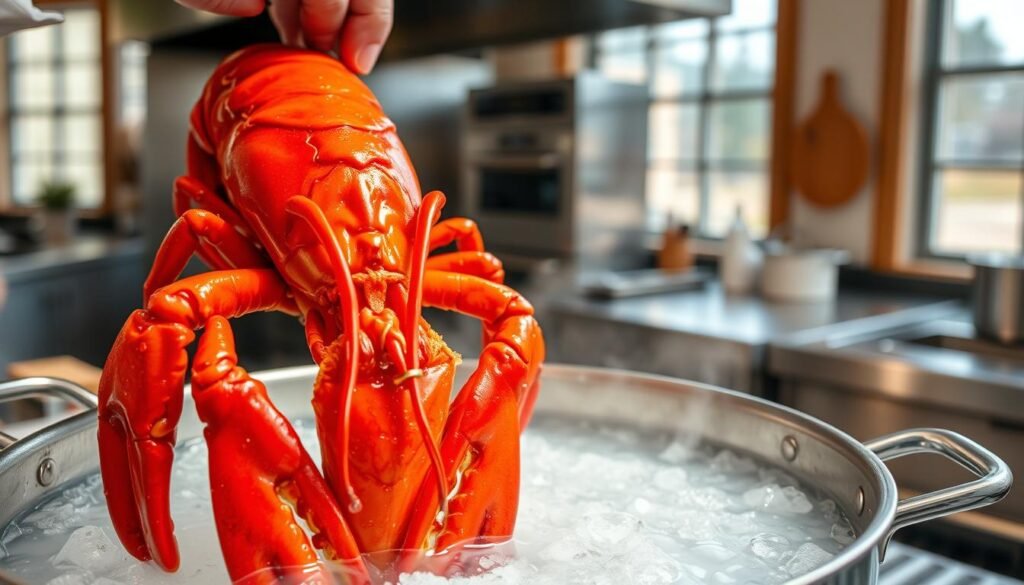
Tips for Extracting Lobster Meat
After cooking your lobster, the next step is to get the meat out. This can be tricky, but with the right technique, you can get the most out of your lobster. Start by twisting off the claws and legs, then crack them open to get the meat. For the body, split it in half lengthwise and carefully remove the meat from the shell.
It’s important to be gentle when doing this to avoid shredding the meat. Also, make sure to remove any tomalley (the lobster’s liver) and coral (the lobster’s eggs), as these can add extra flavor to your lobster roll or other dishes.
By following these steps and tips, you’ll be well on your way to creating a delicious lobster roll that’s sure to impress. Whether you’re boiling or steaming your lobster, the key is to cook it just until it’s done, then carefully extract the meat for your roll.
How to Make the Perfect Lobster Salad
A great lobster salad is the core of a fantastic lobster roll. I’ll show you how to make it. It’s not just about mixing lobster with ingredients. It’s about finding the right balance of flavors that highlights the lobster’s sweetness.
Mixing the Ingredients
First, you need fresh lobster meat. Mix it gently with mayonnaise, lemon juice, and a bit of chopped herbs like parsley or chives. Don’t overmix, as it can make the lobster tough. You want to lightly coat it with the dressing to keep it tender.
For a twist, add a splash of limoncello to your salad. It’s like in some Italian seafood salads. It brings a nice citrus taste that goes well with the lobster.
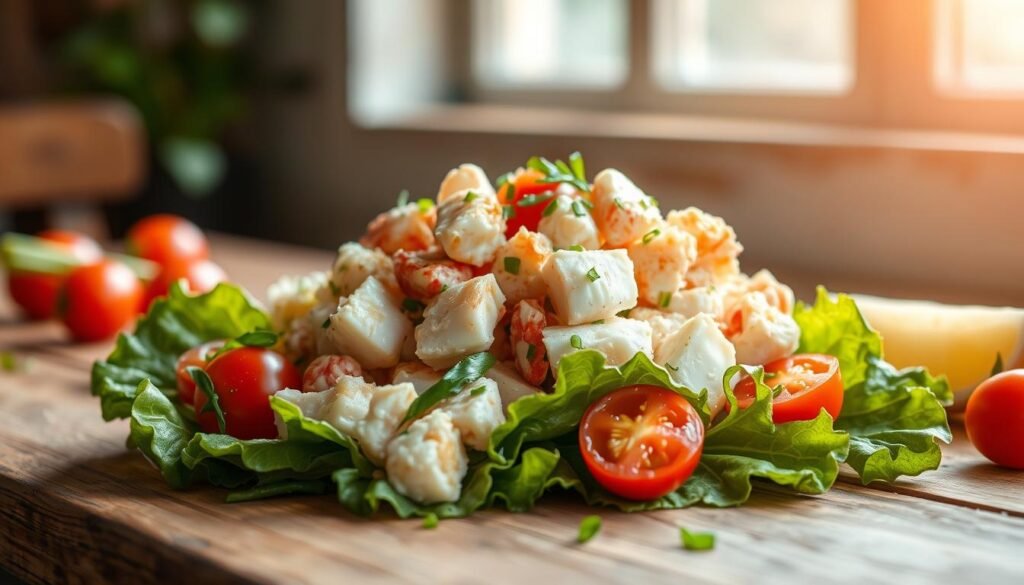
Seasoning Tips for Flavor
Seasoning is key to a delicious lobster salad. Start with salt and black pepper to boost the flavors. Taste it and adjust the seasoning if needed. A squeeze of fresh lemon juice can add brightness. A minced shallot or paprika can add depth.
Remember, the goal is to enhance the lobster’s flavor without overpowering it. Taste often and adjust your seasoning to get it just right.
Assembly of Your Lobster Roll
Now that we have our lobster salad ready, it’s time to put it all together. Assembling the lobster roll is easy but needs some care to get it perfect.
Toasting the Bread
Toasting the bread is key to making your lobster roll amazing. Use a grilled or toasted bun for a nice crunch. Place the buns on a baking sheet and toast in a preheated oven at 350°F (175°C) for about 5 minutes, or until lightly browned.
Serving Suggestions
After toasting the bread, it’s time to assemble and serve. Put a generous amount of lobster salad on the toasted bun. You can serve it as is, or add some additional flavor with a squeeze of lemon or a sprinkle of paprika. Serve with a side that complements the lobster, like a refreshing salad or crispy potato chips.
For a unique twist, pair your lobster roll with a limoncello spritz or a similar refreshing cocktail. It helps balance the richness.
Side Dishes to Pair with Lobster Rolls
When you serve lobster rolls, the right side dishes can make the meal even better. It’s important to choose items that enhance the lobster’s flavor without taking over.
Classic Potato Chips
Classic potato chips are a great match for lobster rolls. Their crunchy texture and salty taste are a nice contrast to the soft lobster. Try flavored chips like garlic parmesan or sea salt and vinegar for something different.
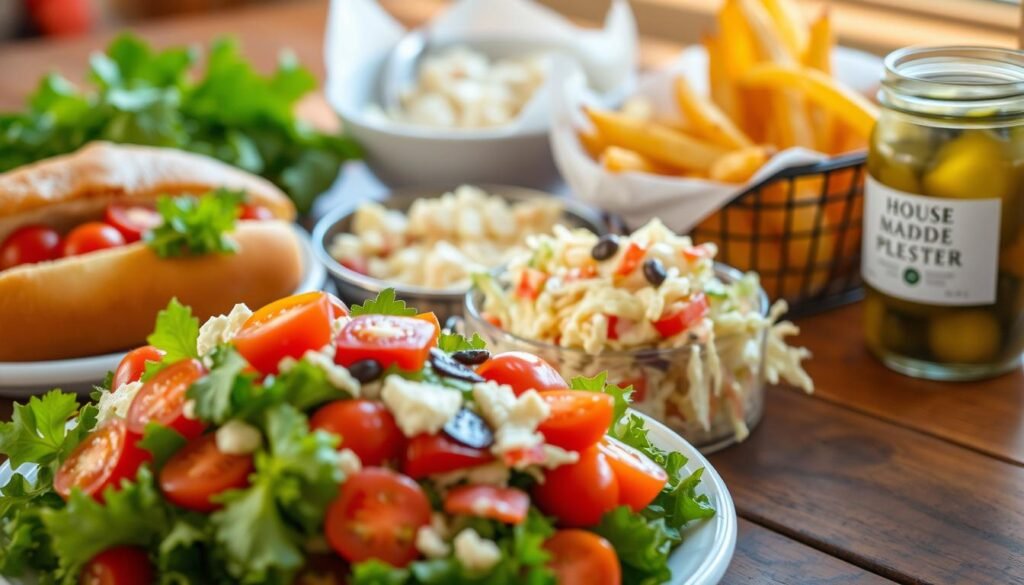
Coleslaw Recipes
Coleslaw is another favorite side dish for lobster rolls. A traditional coleslaw with cabbage, mayonnaise, and vinegar is refreshing. For a unique touch, try a limoncello-infused coleslaw for a citrusy twist.
| Side Dish | Description | Pairing Reason |
|---|---|---|
| Classic Potato Chips | Crunchy, salty, and simple | Contrasting texture and flavor |
| Coleslaw | Refreshing, creamy, and tangy | Balances the richness of lobster |
Exploring these side dishes shows how the right choices can improve your meal. Whether you choose simple potato chips or a creative limoncello coleslaw, your lobster roll meal will be a success.
Variations on the Classic Lobster Roll
Lobster rolls can be made in many exciting ways. This makes them loved in different places.
There are many regional styles of lobster rolls in the United States.
Connecticut vs. Maine Style
The debate between Connecticut and Maine style lobster rolls is long-standing. Maine style uses lightly dressed lobster meat with mayonnaise, celery, and lemon. It’s served on a toasted bun. On the other hand, Connecticut style has lobster meat tossed in melted butter, also on a toasted bun.
“The difference between Maine and Connecticut lobster rolls is more than just dressing,” says a famous chef. “Maine style is light and refreshing, while Connecticut style is rich and indulgent.”
Spicy Lobster Roll Inspiration
For a spicy twist, try adding jalapeños or spicy mayo to your lobster roll. “A squeeze of fresh lime juice and some cilantro can also boost the flavor,” a culinary expert advises.
Some might try a limoncello-infused lobster roll. It mixes citrusy liqueur with traditional ingredients for a unique taste.
- Add diced jalapeños for a spicy kick
- Use spicy mayo as a dressing
- Incorporate fresh lime juice and cilantro for added freshness
Trying different flavors and ingredients lets you make your own lobster roll. Whether you like traditional or innovative styles, the fun is in the making and tasting.
Storing Leftovers Safely
To keep your lobster salad fresh, it’s important to know how to store it right. Storing it properly keeps your lobster rolls tasting great and safe to eat.
Best Practices for Refrigeration
Refrigerating your lobster salad correctly is key. Here are some tips to follow:
- Store the lobster salad in an airtight container to prevent moisture and other flavors from affecting it.
- Keep the container at the back of the refrigerator where it’s coldest, typically below 40°F (4°C).
- Avoid cross-contamination by keeping the lobster salad away from raw meats and other potential bacterial sources.
Tip: If you have a lot of leftover lobster salad, consider dividing it into smaller portions before refrigerating. This helps it chill faster and more evenly.
How Long Can You Keep Lobster Salad?
The shelf life of lobster salad depends on several factors, including storage conditions and the freshness of the ingredients used. Generally, lobster salad can be safely stored in the refrigerator for 1 to 2 days. It’s essential to check the salad for any signs of spoilage before consuming it, such as off smells or slimy texture.
For longer storage, consider freezing the lobster meat before making the salad. But, freezing and thawing can change the lobster’s texture. If you freeze, use airtight containers or freezer bags to prevent freezer burn.
To give you a better idea, here’s a simple table outlining the storage guidelines:
| Storage Method | Duration | Notes |
|---|---|---|
| Refrigeration | 1-2 days | Keep in airtight container below 40°F (4°C) |
| Freezing (lobster meat) | Up to 3 months | Use airtight containers or freezer bags |
Conclusion: Enjoying Your Homemade Lobster Rolls
Now that you’ve learned how to make lobster rolls, it’s time to enjoy them. This experience combines fresh ingredients with the joy of sharing a meal. It’s a special way to connect with others.
Sharing the Delight
Invite friends and family to try your lobster rolls. Serve them with a refreshing limoncello recipe for a twist. The mix of lobster and citrusy limoncello will wow your guests.
Making it a Special Occasion
Make lobster rolls a special treat. They’re perfect for summer barbecues, coastal dinners, or family gatherings. The fun is in being creative with how you present and serve them.
Keep trying new recipes and variations as you enjoy your lobster rolls. The world of lobster rolls is endless, and there’s always something new to try.

